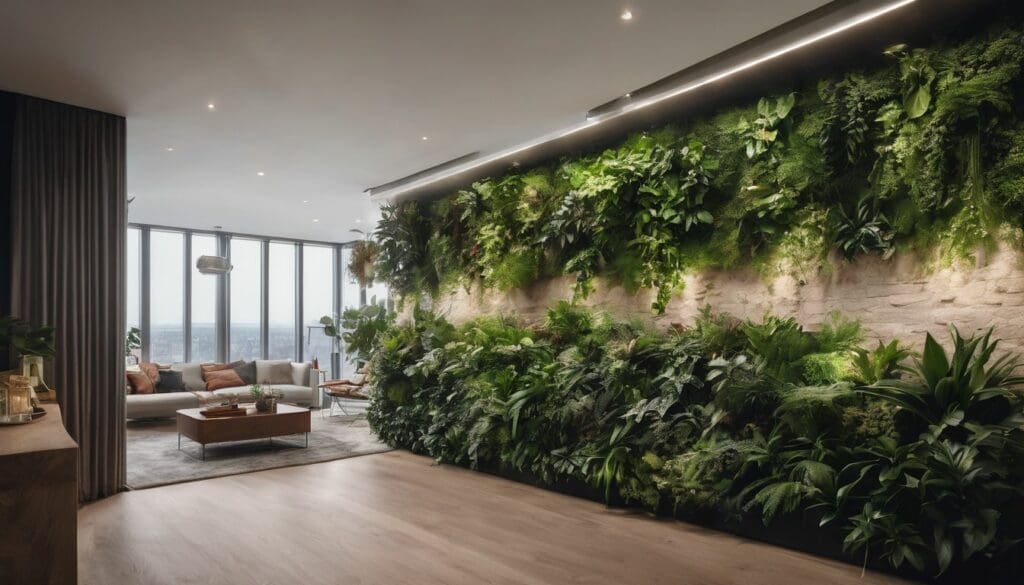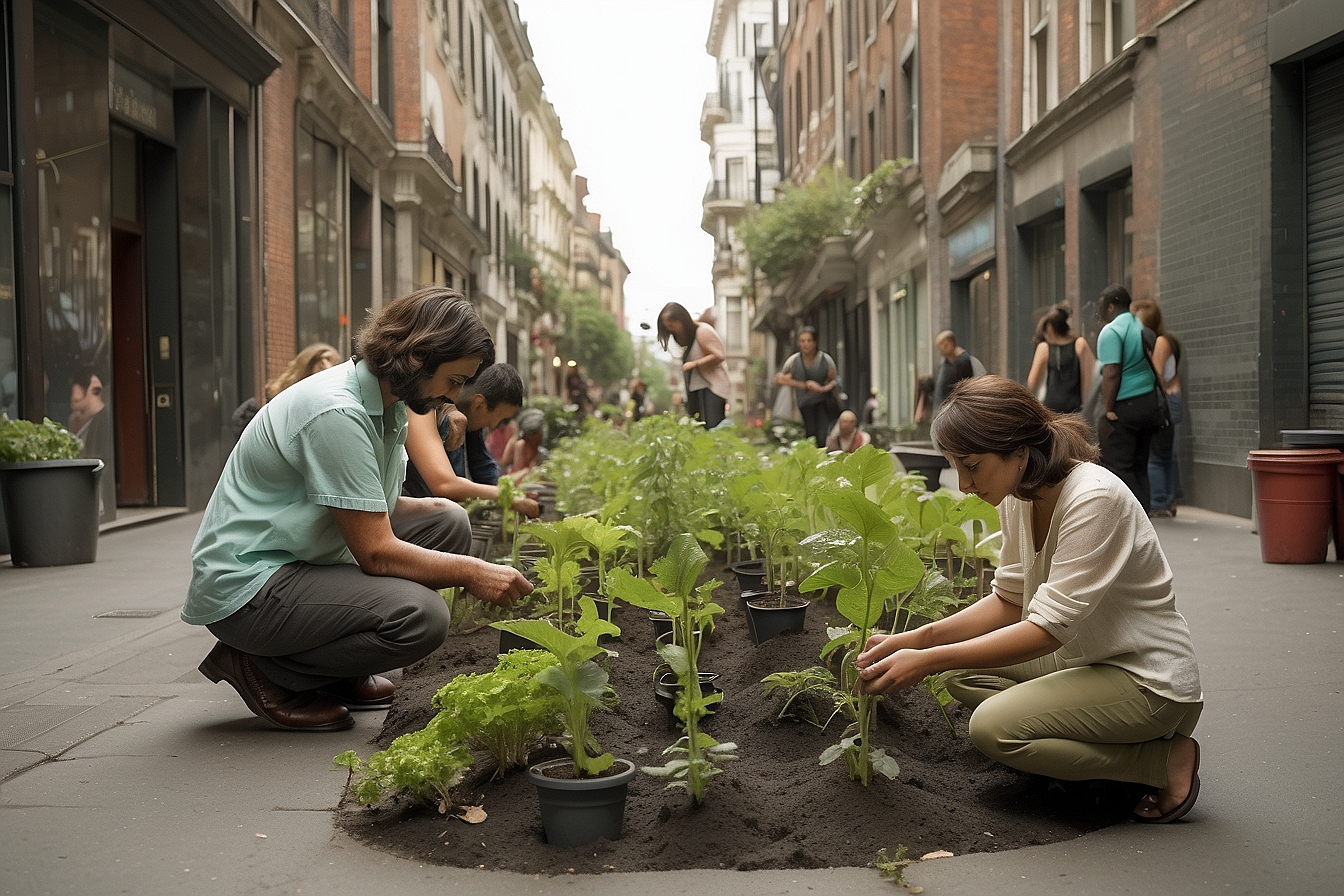Amidst the sprawling urban landscape, where shades of grey seem all-encompassing—our buildings cloaked in concrete and steel—a yearning for verdant splendour takes root. We share your desire to intersperse the city’s harsh lines with pockets of serene greenery.
Our exploration into this realm is fuelled by staggering insights; consider this: a mere square metre of living wall can filter a full 2.3 kg of CO2 every year.
Guided by such compelling evidence, we’re dedicated to shedding light on how you can weave this lush tapestry into the fabric of our urban existence. Whether it’s transforming a stark balcony or bringing life to a bare wall, we will be your companions on this journey towards cultivating an enchanting urban oasis amidst the hustle and bustle.
Together, let us sow seeds for a greener tomorrow!
Key Takeaways
- Green walls are transforming urban environments by providing natural beauty and creating homes for wildlife, with every square metre filtering 2.3 kg of CO2 annually.
- By improving air quality and offering thermal regulation, green walls act as a sustainable solution for eco-friendly urban living, reducing pollution and energy costs.
- Technological advancements in green wall systems promote efficient watering and plant growth, ensuring their longevity and effectiveness in urban landscapes.
- The integration of green walls supports local food production through urban agriculture, fostering community engagement and education on sustainability.
- As cities embrace green walls, they move towards sustainable architectures that mitigate heat island effects and prioritise environmental conservation.
Green Walls: Transforming Urban Spaces
Green walls have the ability to turn unused urban spaces into vibrant oases, revolutionising the way we think about city landscapes. By bringing nature to the concrete jungle, green walls are transforming urban environments for the better.
From Dead Space to Oasis
We transform forgotten corners of our cities into vibrant oases with urban greenery. Imagine once-drab walls now bursting with life, where vertical gardens climb towards the sky. This isn’t just a splash of colour on concrete; it’s sustainable urban design in action.
Through these living walls, we’re revolutionising how we interact with nature in bustling cityscapes.
Every square inch has potential for biodiversity conservation and climate change mitigation. By integrating green building techniques, we invite a myriad of benefits: urban cooling solutions come hand-in-hand with improved indoor air quality and noise reduction.
Now let’s delve into another transformative aspect that shapes our everyday lives: “A Revolution in Urban Landscapes”.
A Revolution in Urban Landscapes
Transforming urban spaces from dead, uninspiring areas into vibrant, green environments is a revolution in urban landscapes. The integration of green walls within cityscapes not only adds aesthetic beauty but also significantly contributes to environmental sustainability.
Urban greening with vertical gardens positively impacts the air quality by reducing pollutants and enhancing biodiversity while creating habitats for wildlife. Moreover, the introduction of green walls aids in regulating temperatures, noise reduction, and promoting sustainable architecture.
It is evident that this innovation has evolved to become an essential element of eco-friendly design and biophilic architecture in urban settings.
The power of green walls extends beyond mere visual appeal; it represents a shift towards sustainable living through innovative and environmentally conscious practices such as integrating pollinator support, supporting conservation efforts, and fostering urban gardening initiatives.
The Benefits of Green Walls
Green walls offer a multitude of benefits for urban homes, from restoring nature in concrete jungles to improving air quality and providing thermal regulation. They also create habitats for biodiversity and wildlife, while adding a visually pleasing and health-boosting element to indoor spaces.
Nature Restoration
Restoring nature in urban environments through green walls is vital for creating a healthier and more sustainable living space. By introducing diverse plant species within these structures, we can create mini ecosystems that support local wildlife and promote biodiversity.
Urban areas often lack natural green spaces, but integrating green walls allows us to bring the benefits of nature back into our cities while contributing to the overall health of our planet.
Through the use of innovative designs and careful selection of plant species, green walls also provide an opportunity to improve air quality by removing pollutants from the surrounding environment.
Improved Air Quality
Green walls play a substantial role in improving air quality in urban environments. By harnessing the natural ability of plants to purify the air, these vertical gardens act as green lungs within cities, filtering out harmful pollutants such as carbon dioxide and particulate matter.
As a result, they contribute to cleaner and healthier air for both indoor and outdoor spaces. The abundance of plant life also helps to reduce the presence of volatile organic compounds (VOCs) indoors, further enhancing the overall air quality.
Expanding on this topic, let’s explore how green walls contribute to thermal regulation in urban areas.
Thermal Regulation
Improved air quality is not the only benefit of green walls. Thermal regulation also plays a significant role in creating healthier and more sustainable urban environments. By providing insulation benefits, green walls can help to reduce energy consumption by keeping buildings cooler in summer and warmer in winter.
This eco-friendly design element contributes to urban greening initiatives, making indoor spaces more comfortable while lowering carbon footprints.
In addition, thermal regulation through green walls promotes sustainability by lessening the need for excessive heating and cooling systems. It’s a step towards eco-conscious living that aligns with the ideals of environmentally conscious individuals who support conservation and environmental protection efforts.
Noise Reduction
Green walls play a vital role in noise reduction, creating a peaceful and serene environment within urban homes. The plants effectively absorb and dissipate sound waves, reducing the impact of external noise pollution.
This natural barrier ensures a quieter indoor space, supporting relaxation and focus while creating a calmer atmosphere for residents.
By embracing green walls in urban homes, individuals can enjoy the benefits of noise reduction alongside improved air quality and nature restoration. These sustainable design choices not only enhance the aesthetic appeal but also contribute to healthier and more harmonious living environments.
Biodiversity and Wildlife Habitat
Green walls play a crucial role in supporting urban biodiversity and wildlife habitat. By providing green spaces within the city, they offer a home for insects, birds, and small mammals.
These living walls contribute to the conservation of indigenous plants while also attracting various species of pollinators. Furthermore, green walls encourage ecological balance by creating ecosystems that support diverse forms of wildlife.
The presence of green walls in urban environments not only enhances their aesthetic appeal but also provides essential habitats for local fauna to flourish. It’s important we continue implementing these eco-friendly designs to ensure our cities remain biodiverse and sustain wildlife populations for future generations.
Aesthetically Pleasing and Health-Boosting
Green walls not only contribute to the visual appeal of urban homes but also offer numerous health benefits. The lush greenery adds a touch of natural beauty, creating a serene and calming environment within our living spaces.
This aesthetic enhancement promotes relaxation and reduces stress, contributing to an overall sense of well-being. Moreover, the presence of green walls can also positively impact air quality, as plants naturally filter out pollutants and produce oxygen, leading to fresher indoor air for inhabitants.
In addition to their visual appeal, green walls can also boost the health of urban dwellers by providing opportunities for gardening and fostering a deeper connection with nature. Engaging in activities such as tending to plants on these vertical gardens can be therapeutic and rewarding while encouraging sustainable practices at home.
Examples of Successful Green Wall Projects
– The integration of green walls in urban environments has led to the creation of stunning and vibrant living landscapes, bringing nature to the concrete jungle.
– These innovative projects have showcased the potential for transforming urban spaces into thriving ecosystems that benefit both people and wildlife.
Bringing Nature to the Concrete Jungle
Bringing nature to the concrete jungle can transform urban environments into thriving ecosystems. Green walls are not just aesthetically pleasing; they also provide a refuge for biodiversity and wildlife habitats, making cities more environmentally friendly.
These green spaces effectively combat air pollution by reducing harmful emissions and enhancing air quality, contributing to healthier urban living. Integrating nature in cityscapes is essential for creating sustainable and eco-friendly urban areas that support conservation efforts.
Incorporating green walls into urban homes provides an opportunity for individuals to contribute positively to their environment while enjoying the visual and health benefits of indoor plants.
Transforming Urban Environments
As we consider the impact of green walls, it’s clear that these vertical gardens hold immense potential for transforming urban environments into vibrant, sustainable spaces. By integrating green walls into urban landscapes, we can revolutionise the concrete jungle and create lush, biodiverse habitats for both plants and animals.
These living walls not only beautify our cities but also bring nature back to where it belongs – in the heart of urban environments. With their ability to purify air, regulate temperature, reduce noise pollution, and support wildlife, green walls offer a powerful solution for greening our cities and making them healthier places to live.
Incorporating green walls into cityscapes presents an opportunity to reimagine urban spaces as thriving ecosystems that benefit both people and the environment. By harnessing this innovative technology, we can create more sustainable and resilient cities while enhancing the well-being of those who call them home.
The Future of Green Walls
The future of green walls holds great potential for advancements in technology, leading to sustainable cityscapes and urban agriculture. With innovative ideas and continued investment, we can expect to see an even greater integration of nature within our urban environments.
Advancements in Technology
New technology has revolutionised the way green walls are designed and maintained. Innovations in irrigation systems have made it possible to water vertical gardens efficiently, reducing water wastage and ensuring plant health.
Furthermore, the use of smart sensors and automated monitoring tools allows for real-time tracking of environmental conditions, optimising plant growth and health. Green wall systems now incorporate modular designs and lightweight materials, making installation more flexible and cost-effective.
Advancements in technology have also contributed to the development of sustainable materials that enhance the longevity and effectiveness of green walls. For instance, bio-based substrates offer improved nutrient retention while promoting plant growth.
Potential for Sustainable Cityscapes
Green walls have the potential to transform urban cityscapes into sustainable and environmentally friendly spaces. By integrating green walls into urban architecture, cities can mitigate the heat island effect, reduce energy consumption, and improve air quality.
These living structures also support biodiversity by providing habitats for birds, insects, and other wildlife in otherwise barren urban environments. The incorporation of green walls presents an opportunity for cities to create vibrant and sustainable landscapes that contribute to a healthier planet.
As we look towards the future of our cities, incorporating green walls provides a promising path towards creating sustainable urban environments that prioritise environmental conservation while enhancing our daily lives with nature-focused designs.
Potential for Urban Agriculture
Urban agriculture has the potential to thrive with the integration of green walls in urban spaces. By utilising vertical space, cities can cultivate fruits, vegetables, and herbs in limited areas, contributing to local food production.
This innovative approach not only promotes sustainable living but also reduces the carbon footprint associated with transporting produce from remote rural areas to urban centres.
Furthermore, urban agriculture on green walls can foster a sense of community among city dwellers as they come together to collectively nurture and harvest crops. Not only does this promote local food security, but it also creates opportunities for education about sustainable farming practices in an urban setting.
The evolution of green walls holds promise for sustainable and eco-friendly cities that support local food production.
Conclusion
In conclusion, green walls have the potential to transform urban spaces into vibrant oases. They bring numerous benefits such as improved air quality, noise reduction, and enhanced biodiversity.
With advancements in technology, green walls offer a promising future for sustainable cityscapes and urban agriculture. This innovative approach not only creates aesthetically pleasing environments but also contributes to the restoration of nature within urban homes.
FAQs
1. What is a green wall in an urban home?
A green wall in an urban home is a space specially designed to grow plants vertically inside or outside the house, which can improve air quality.
2. How do green walls benefit city dwellers?
Green walls help city residents by refreshing the air they breathe and bringing more nature into tight, urban spaces.
3. Can installing a green wall at my place make the air cleaner?
Yes, having a green wall can clean up your living space’s air by removing pollutants and producing fresh oxygen.
4. Is it hard to take care of a green wall?
It’s not too tough; with the right tools and some basic knowledge about plants, you can easily maintain a healthy green wall in your urban home.





